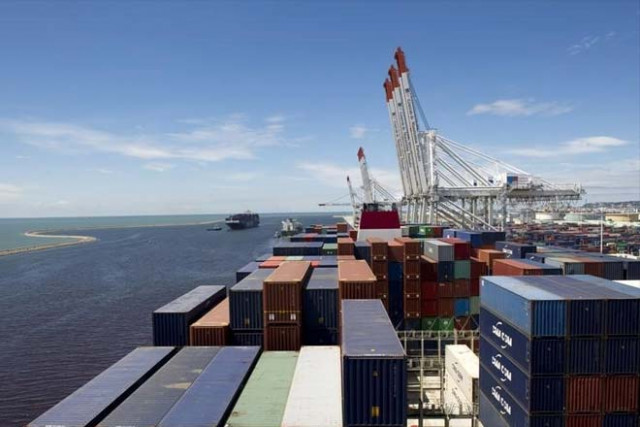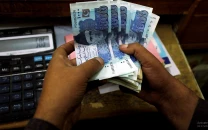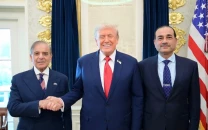Stagnant export growth indicates severe structural challenges
Policymakers must focus on increasing global competitiveness of domestic firms

Representational image. PHOTO: REUTERS
Although imports declined by 9.86% in FY19 over the value reported in FY18, exports too dropped by 1%. The lack of export growth is disconcerting. The failure to increase exports at a time when the real effective exchange rate is close to 100 is a cause for concern.
The lack of export growth at a time when exporters receive greater incentives accompanied by weakening currency suggests severe structural issues. Although imports may continue to decline as demand falls for many major goods, it is imperative that policymakers focus on addressing the issue of stagnant export growth and increasing global competitiveness of domestic firms.
According to the FY19 export data extracted from the PBS, the petroleum group was the only major group that showed an increase in value in dollar terms over FY18. However, a closer look suggests that export of knitwear and readymade garments also increased in value but the increase in quantity significantly outweighed the rise in dollar terms.
Trade deficit shrinks 15.3% to $31.8b in FY19
Benefits in rupee terms failed to translate into an increase in much-needed dollar revenues. Interestingly, there was an increase in export of petroleum crude by 49% as more than $285 million worth of the product was exported from Pakistan in FY19, suggesting a mismatch between its import and local demand.
On the other hand, imports declined in dollar terms in FY19 as compared to the value in FY18 for all major products except for petroleum. Import of machinery fell by more than 20% with a decrease of more than 50% in power generating machinery and equipment and fall of 18% in import of electrical machinery and apparatus.
Furthermore, there was a decline in the import of road motor vehicles driven by completely built units (CBUs). Import of parts and accessories of vehicles dropped by 15%, suggesting a fall in local production of automobiles.
Import of petroleum crude and liquefied natural gas (LNG) increased by 12% and 44% respectively. This points to the restructuring of imports as the composition has shifted from import of machinery towards import of items in the petroleum group.
Export receipts
According to data of export receipts extracted from the State Bank of Pakistan (SBP), there was an increase in export receipts from China and the United States between July 2018 and May 2019 compared to the same period of previous year.
On the other hand, export receipts from Afghanistan, Germany and the United Kingdom either stagnated or decreased. The decline in export receipts from Afghanistan was calculated at 30%.
Considering the data of import payments, the payments to China decreased by approximately 10%, payments to Japan dipped by 16% and payments to Singapore decreased by 22%.
On the other hand, payments to Qatar increased by more than 33% due to the increase in demand for LNG from Qatar. This again suggests a change in composition as Pakistan has increased import of fuel and reduced import of machinery, vehicles and electronic appliances.
Although it is obvious that the burgeoning trade deficit may require measures to reduce the gap, results will only be sustainable if exports increase. The policymakers must consider integration of the country into regional and global value chains.
This will require efforts to improve quality and standards of production. Even though larger countries are adopting policies to limit foreign trade, countries such as Vietnam and those belonging to the African Union have recently signed free trade agreements (FTAs) at global and regional levels.
Export of services and its exponential potential
Trade agreements help to not only lower the cost of production but also raise export competitiveness of firms as they provide access to essential markets. Unfortunately, poorly negotiated trade agreements can also lead to high levels of trade deficit.
Trade with China
Pakistan-China FTA is blamed for the burgeoning trade deficit of Pakistan rather than to be seen as an opportunity to increase exports.
A new phase of the FTA between Pakistan and China was signed in April 2019 with the intent of boosting exports from Pakistan to China and reducing the large trade deficit.
A closer look at the agreement suggests that upstream textile producers, such as those producing cotton yarn, have been the biggest beneficiaries in terms of export gains under the FTA.
According to data extracted from the ITC’s Trademap.org for studying trade patterns, China had imported less than $100 million worth of a particular variant of uncombed single cotton yarn from Pakistan in 2005. However, this increased to more than $1.26 billion in 2014.
With total imports by China from Pakistan at $2.8 billion, the focus was highly concentrated in a few products. Downstream industries report a negligible rise.
Pakistan had already received major concessions for export in the first phase but failed to utilise them. Furthermore, China is now providing more relief on tariffs to Pakistani exporters.
Therefore, establishing joint ventures with Chinese firms is essential to increase export of products receiving immediate tariff relief, particularly those that are not commonly exported to China but have potential, such as leather and plastic products.
On the other hand, tariffs on imports from China into Pakistan are also likely to be reduced further for products that are frequently imported such as machinery, chemicals and allied products, base metals and vehicles.
It is imperative to note that the FTA with China laid the foundation of the China-Pakistan Economic Corridor (CPEC) as it provided easier access for import of essential Chinese goods. The success of CPEC should be linked to industrial development in Pakistan.
FTAs with various countries not only facilitate market access but also provide opportunities to procure inputs at the most competitive rates, especially when local producers have failed to produce quality substitutes.
Promoting trade linkages with the Association of Southeast Asian Nations (Asean) can benefit Pakistan and its small and medium enterprises as several Asean member countries specialise in the trade of parts and components.
It is essential that the government balances its desire to accumulate customs revenue and improve business competitiveness.
The writer is Assistant Professor of Economics and Research Fellow at CBER, IBA
Published in The Express Tribune, July 29th, 2019.
Like Business on Facebook, follow @TribuneBiz on Twitter to stay informed and join in the conversation.

1728020501-0/Express-Tribune-Web-(13)1728020501-0-208x130.webp)

















COMMENTS
Comments are moderated and generally will be posted if they are on-topic and not abusive.
For more information, please see our Comments FAQ